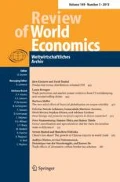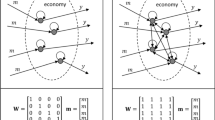Abstract
The business literature has long recognized the importance of multinationals’ distribution networks. The empirical analysis of distribution-oriented FDI has, however, received little attention which is at least partly due to the lack of appropriate data. We present a slightly modified version of Helpman et al. (Am Econ Rev 94(1):300–316, 2004) that explicitly models the possibility for a multinational firm to export through its wholesale trade affiliate. We analyze the multinational firms’ choice between foreign production and foreign distribution. Our empirical analysis uses different discrete choice models and alternative specifications for several sub-samples of multinational firms. Our results show that the choice between distribution and production-oriented FDI is based on the trade-off between fixed and variable costs.
Similar content being viewed by others
Notes
This result confirms the findings of Kimura and Ando (2005).
Given that observed firm structures are much more complex than the structure assumed in the theory, it is not a matter of course that the data support the discrete choice approach.
This literature is mainly based on theories of trade intermediation that improves the matching between producers and consumers (see Antrás and Costinot 2011; Rauch and Watson 2004; or Petropoulou 2007). Our focus differs since we analyze the behavior of multinational firms that are not intermediaries.
The traditional classification has been into horizontal and vertical FDI. Horizontal FDI occurs when a multinational duplicates its activities abroad to serve the foreign market. Vertical FDI occurs when a multinational firm splits its production process across borders.
See Lipponer (2009) for a detailed description of the data and the definition of FDI underlying the German FDI statistics.
This number slightly exceeds the number of affiliate-year-combinations (222,701), because some affiliates are owned by a joint venture of two or more German parent firms. Thus, there are more parent-affiliate combinations than affiliates in the sample.
Since we do not take into account the parent firms that are classified in the wholesale sector, the wholesale trade affiliates are different from simple trade intermediaries. They sell goods produced at home, as reported by Anderson (2008).
We use the two-digit NACE classification to derive the information indicating whether the multinational meets this necessary condition. The two-digit classification distinguishes 16 non-service sectors. The share of firms meeting the criteria is only slightly smaller if we use 64 manufacturing sectors instead.
They do not provide information on the proportion of affiliates in the wholesale trade sector.
Equation (7) involves only real variables. The price indexes cancel in Eq. (5). In our empirical analysis, we compare decisions at different points in time. To make these decisions comparable, we must eliminate the price effects of inflation and exchange rate changes. For the expected fixed costs, this is done by scaling. Trade costs are captured by variables that are unaffected by inflation and exchange rate changes.
This concerns mostly low-income countries.
Moulton (1990) showed that in the case of firm-level regressions including aggregated sector variables, the statistical significance from the OLS regression for the aggregate variable of interest, in our case the fixed costs share and to some extend the wage differences will be misleading. To address this issue, the standard errors are corrected for a correlation between observations belonging to the same sector.
The manufacturing wages were 5 times higher in France than in the Czech Republic in 2003.
Australia is 18 times further away from Germany than France is.
A referee proposed this subsample to account for the horizontal firm structure that we have assumed in the theory.
The incidental parameter problem let us refrain from probit fixed effects regressions. This problem does not arise in fixed effects logit models (Wooldridge 2002).
References
Alfaro, L., & Charlton, A. (2009). Intra-industry foreign direct investment. American Economic Review, 99(5), 2096–2119.
Anderson, T. (2008). US Affiliates of foreign companies: Operations in 2006. Survey of Current Business, 88(8), 186–203. http://www.bea.gov/scb/pdf/2008/08August/0808_affiliate.pdf.
Antrás, P., & Costinot, A. (2011). Intermediated trade. The Quarterly Journal of Economics, 126(3), 1319–1374.
Bernard, A. B., Jensen, J. B, Redding, S. J., & Schott, P. K. (2010). Wholesalers and retailers in US trade. American Economic Review, 100(2), 408–413.
Blonigen, B. A. (2001). In search of substitution between foreign production and exports. Journal of International Economics, 53(1), 81–104.
Blonigen, B. A., Davies, R. B., & Head, K. (2003). Estimating the knowledge-capital model of the multinational enterprise: Comment. American Economic Review, 93(3), 980–994.
Blum, B. S., Claro, S., & Horstmann, I. J. (2010). Facts and figures on intermediated trade. American Economic Review, 100(2), 419–423.
Brainard, S. L. (1997). An empirical assessment of the proximity-concentration trade-off between multinational sales and trade. American Economic Review, 87(4), 520–544.
Buch, C. M., Kleinert, J., Lipponer, A., & Toubal, F. (2005). Determinants and effects of foreign direct investment: Evidence from German firm-level data. Economic Policy, 20, 53–110.
Carr, D. L., Markusen, J. R., & Maskus, K. E. (2001). Estimating the knowledge-capital model of the multinational enterprise. American Economic Review, 91(3), 693–708.
Caves, R. E. (1971). International corporations. The industrial economics of foreign investments. Economica, 38(149), 1–27.
CEPII (2008a). Distances. http://www.cepii.fr/anglaisgraph/bdd/distances.htm.
CEPII (2008b). Trade & Production. http://www.cepii.fr/anglaisgraph/bdd/TradeProd.htm.
Clausing, K. (2000). The international trade of multinational firms: The empirical behaviour of intrafirm trade in a gravity equation model (CEPS Working Document No. 147). Brussels: Centre for European Policy Studies.
Daniels, P. W. (2000). Export of services or servicing exports? Geografiska Annaler, 82(1), 1–15.
Dunning, J. H. (1993). Multinational enterprises and the global economy. Suffolk: Addison-Wesley.
Fontagné, L., & Toubal F. (2010). FDI and firms’ performances. CEPII, mimeograph.
Fryges, H. (2007). The change of sales modes in international markets: Empirical results for German and British high-tech firms. Progress in International Business Research, 1, 139–185.
Gray, H. P. (1999). Global economic involvement. A synthesis of modern international economics. Copenhagen: Copenhagen Business School Press.
Greaney, T. M. (2005). Measuring network effects on trade: are Japanese affiliates distinctive? Journal of the Japanese and International Economies, 19(2), 194–214.
Hanson, G. H., Mataloni, R. J., & Slaughter, M. J. (2005). Vertical production networks in multinational firms. The Review of Economics and Statistics, 87(4), 664–678.
Helpman, E., Melitz, M. J., & Yeaple, S. R. (2004). Exports versus FDI with heterogeneous firms. The American Economic Review, 94(1), 300–316.
Hirsch, S. (1993). The globalization of services and service-intensive goods industries. In K. P. Sauvant & P. Mallampally (Eds.), Transnational corporation in services. United Nations Library on Transnational Corporations, vol 12. London and New York: Routledge.
Kimura, F., & Ando, M. (2005). Two-dimensional fragmentation in East Asia: Conceptual framework and empirics. International Review of Economics and Finance, 14(3), 317–348.
Kiyota, K., & Urata, S. (2005). The role of multinational firms in international trade: The case of Japan (RIETI Discussion Paper Series 05-E-012). Tokyo: Research Institute of Economy, Trade and Industry.
Kleinert, J., & Toubal, F. (2010). Gravity for FDI. Review of International Economics, 18(1), 1–13.
Krautheim, S. (2009). Export-supporting FDI. (Deutsche Bundesbank Discussion Paper Series 1: Economic Studies 20/2009). Frankfurt: Deutsche Bundesbank, Research Centre.
Lipponer, A. (2009). Microdatabase direct investment—MiDi: A brief guide.
Markusen, J. R., & Venables, A. J. (1998). Multinational firms and the new trade theory. Journal of International Economics, 46, 183–203.
Markusen, J. R., & Venables, A. J. (2000). The theory of endowment, intra-industry and multinational trade. Journal of International Economics, Technical Dokumentation, Frankfurt: Deutsche Bundesbank, 52, 209–234.
Moulton, B. (1990). An illustration of a pitfall in estimating the effects of aggregate variables on micro units. Review of Economics and Statistics, 72(2), 334–338.
Petropoulou, D. (2007). Information costs, networks and intermediation in international trade. (Economics Series Working Papers 370). Department of Economics, University of Oxford.
Rauch, J.E., & Watson, J. (2004). Network intermediaries in international trade. Journal of Economics and Management Strategy, 13(1), 69–93.
UNCTAD (2002). Transnational corporations and export competitiveness. World Investment Report, New York and Geneva: United Nations.
Wooldridge, J. M. (2002). Econometric analysis of cross-section and panel data. Cambridge: MIT Press.
Yamawaki, H. (1991). Exports and foreign distributional activities: Evidence on Japanese firms in the United States. The Review of Economics and Statistics, 73(2), 294–300.
Yeaple, S. R. (2003). The complex integration strategies of multinationals and cross-country dependencies in the structure of foreign direct investment. Journal of International Economics, 60(2), 293–314.
Zeile, W. J. (1997). US Intra-firm trade in goods. Survey of Current Business, 77(2), 23–38 (BEA).
Author information
Authors and Affiliations
Corresponding author
Additional information
This paper has substantially benefited from the comments of Mary Amiti, Peter Egger, Horst Raff, Jim Markusen, Peter Neary, John Romalis, Beata Smarzynska, Nicolas Schmitt, and Maurizio Zanardi. This paper has partly been written while the authors visited the Research Centre of the Deutsche Bundesbank. The hospitality of the Bundesbank, as well as access to the Bundesbank’s micro-database “MIDI” are gratefully acknowledged. This research has received financial support from the Franco-German ANR/DFG program on “FDI in services”. We are, of course, responsible for any remaining errors.
About this article
Cite this article
Kleinert, J., Toubal, F. Production versus distribution-oriented FDI. Rev World Econ 149, 423–442 (2013). https://doi.org/10.1007/s10290-013-0158-1
Published:
Issue Date:
DOI: https://doi.org/10.1007/s10290-013-0158-1




